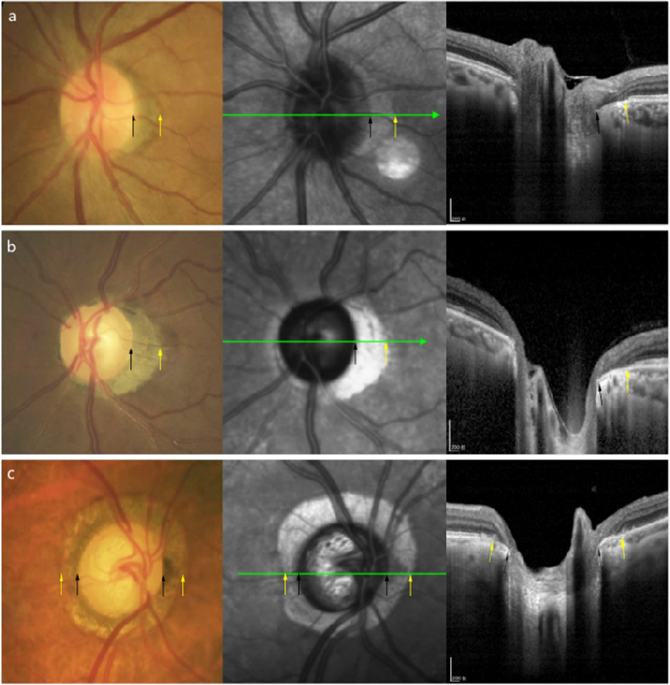Our official English website, www.x-mol.net, welcomes your
feedback! (Note: you will need to create a separate account there.)
Morphological features of parapapillary beta zone and gamma zone in chronic primary angle-closure glaucoma
Eye ( IF 2.8 ) Pub Date : 2019-08-30 , DOI: 10.1038/s41433-019-0541-9
Kunte Shang 1, 2 , Xinxin Hu 1, 2 , Yi Dai 1, 2
Eye ( IF 2.8 ) Pub Date : 2019-08-30 , DOI: 10.1038/s41433-019-0541-9
Kunte Shang 1, 2 , Xinxin Hu 1, 2 , Yi Dai 1, 2
Affiliation

|
Upon completion of this activity, participants will be able to: Describe morphological features of the parapapillary beta and gamma zone in eyes with CACG compared with nonmyopic control eyes, according to an observational cross-sectional study Determine factors associated with morphological features of the parapapillary beta and gamma zone, according to an observational cross-sectional study Identify pathophysiological implications of morphological features of the parapapillary beta and gamma zone in eyes with CACG, according to an observational cross-sectional study Describe morphological features of the parapapillary beta and gamma zone in eyes with CACG compared with nonmyopic control eyes, according to an observational cross-sectional study Determine factors associated with morphological features of the parapapillary beta and gamma zone, according to an observational cross-sectional study Identify pathophysiological implications of morphological features of the parapapillary beta and gamma zone in eyes with CACG, according to an observational cross-sectional study In support of improving patient care, this activity has been planned and implemented by Medscape, LLC and Springer Nature. Medscape, LLC is jointly accredited by the Accreditation Council for Continuing Medical Education (ACCME), the Accreditation Council for Pharmacy Education (ACPE), and the American Nurses Credentialing Center (ANCC), to provide continuing education for the healthcare team. Medscape, LLC designates this Journal-based CME activity for a maximum of 1.0 AMA PRA Category 1 Credit(s)™. Physicians should claim only the credit commensurate with the extent of their participation in the activity. 1.0 Release date: 30 August 2019 Expiration date: 30 August 2020 Post-test link: https://medscape.org/eye/posttest915887 Sobha Sivaprasad has disclosed the following relevant financial relationships: Served as an advisor or consultant for: Allergan, Inc.; Bayer AG; Boehringer Ingelheim Pharmaceuticals, Inc.; Heidelberg Pharma GmbH; Optos; Roche. Served as a speaker or a member of a speakers bureau for: Allergan, Inc.; Bayer AG; Novartis Pharmaceuticals Corporation; Optos. Received grants for clinical research from: Allergan, Inc.; Bayer AG; Boehringer Ingelheim Pharmaceuticals, Inc.; Novartis Pharmaceuticals Corporation; Optos. Kunte Shang, MD, has disclosed no relevant financial relationships. Xinxin Hu, MD, has disclosed no relevant financial relationships. Yi Dai, MD, PhD, has disclosed no relevant financial relationships. Laurie Barclay, MD, has disclosed no relevant financial relationships. To investigate the morphological features of parapapillary beta zone and gamma zone and their associated factors in eyes with chronic primary angle-closure glaucoma (CACG). The observational cross-sectional study included 65 CACG eyes and 65 non-myopic control eyes. On enhanced depth imaging of optical coherent tomography images, the area of parapapillary beta zone and gamma zone, and the peripapillary choroidal thickness at 6 sectors were measured. The optic disc ovality index and Bruch’s membrane opening (BMO) shape were further calculated. Beta zone was present in 103 (79.2%) eyes and gamma zone in 29 (22.3%) eyes. Compared to control eyes, CACG was associated with larger parapapillary beta zone, female gender, and older age (P < 0.01). No significant difference was observed in axial length and peripapillary choroidal thickness between both groups (P > 0.05). In multivariate analysis, beta zone area was positively associated with older age and higher prevalence of CACG (P < 0.01), while a larger gamma zone area was associated with a smaller disc ovality index and a higher BMO ovality ratio (P < 0.01). The peripapillary choroidal thickness at six sectors was decreased with older age (P < 0.01). In mainly non-myopic subjects with or without CACG, larger parapapillary beta zone was correlated with older age and presence of glaucoma, while a larger parapapillary gamma zone was correlated with disc ovality but not with glaucoma. Parapapillary beta zone and gamma zone may play different roles in physiological and glaucomatous changes around optic nerve head.
中文翻译:

慢性原发性闭角型青光眼视乳头旁β区和γ区的形态学特征
根据一项观察性横断面研究 根据一项观察性横断面研究,确定 CACG 眼中乳头旁 β 和 γ 区形态学特征的病理生理学意义 为了支持改善患者护理,该活动已由 Medscape 计划和实施, LLC 和 Springer Nature。Medscape, LLC 获得继续医学教育认证委员会 (ACCME)、药学教育认证委员会 (ACPE) 和美国护士资格认证中心 (ANCC) 的联合认证,可为医疗团队提供继续教育。Medscape, LLC 将此基于期刊的 CME 活动指定为最多 1.0 AMA PRA 类别 1 Credit(s)™。医生应仅申请与其参与活动的程度相称的信用。1. 0 发布日期:2019 年 8 月 30 日到期日期:2020 年 8 月 30 日 测试后链接:https://medscape.org/eye/posttest915887 Sobha Sivaprasad 已披露以下相关财务关系: 担任顾问或顾问: Allergan, Inc .; 拜耳股份公司;勃林格殷格翰制药公司;海德堡制药有限公司;光电; 罗氏。曾担任以下机构的发言人或发言人局成员:Allergan, Inc.;拜耳股份公司;诺华制药公司;光电。获得来自 Allergan, Inc. 的临床研究资助;拜耳股份公司;勃林格殷格翰制药公司;诺华制药公司;光电。医学博士尚昆特未披露任何相关财务关系。胡欣欣,医学博士,已披露没有相关的财务关系。Yi Dai,医学博士,博士,没有披露相关的财务关系。劳里·巴克莱,医学博士,未披露相关财务关系。探讨慢性原发性闭角型青光眼(CACG)眼乳头旁β区和γ区的形态学特征及其相关因素。观察性横断面研究包括 65 只 CACG 眼和 65 只非近视对照眼。在光学相干断层扫描图像的增强深度成像中,测量了乳头旁β区和伽马区的面积以及6个扇区的视乳头周围脉络膜厚度。进一步计算视盘椭圆度指数和布鲁赫膜开口 (BMO) 形状。103 只(79.2%)眼存在 Beta 区,29 只(22.3%)眼存在 gamma 区。与对照眼相比,CACG 与较大的乳头旁β区、女性和年龄较大有关(P < 0.01)。两组间轴长和视乳头周围脉络膜厚度无显着差异(P > 0.05)。在多变量分析中,β 区面积与年龄较大和 CACG 患病率较高呈正相关(P < 0.01),而较大的 γ 区面积与较小的椎间盘椭圆度指数和较高的 BMO 椭圆度比相关(P < 0.01)。6 个扇区的视乳头周围脉络膜厚度随着年龄的增长而降低(P < 0.01)。在主要有或没有 CACG 的非近视受试者中,较大的乳头旁 β 区与年龄较大和青光眼的存在相关,而较大的乳头旁 γ 区与椎间盘椭圆度相关,但与青光眼无关。视乳头旁β区和γ区可能在视神经乳头周围的生理和青光眼变化中起不同的作用。
更新日期:2019-08-30
中文翻译:

慢性原发性闭角型青光眼视乳头旁β区和γ区的形态学特征
根据一项观察性横断面研究 根据一项观察性横断面研究,确定 CACG 眼中乳头旁 β 和 γ 区形态学特征的病理生理学意义 为了支持改善患者护理,该活动已由 Medscape 计划和实施, LLC 和 Springer Nature。Medscape, LLC 获得继续医学教育认证委员会 (ACCME)、药学教育认证委员会 (ACPE) 和美国护士资格认证中心 (ANCC) 的联合认证,可为医疗团队提供继续教育。Medscape, LLC 将此基于期刊的 CME 活动指定为最多 1.0 AMA PRA 类别 1 Credit(s)™。医生应仅申请与其参与活动的程度相称的信用。1. 0 发布日期:2019 年 8 月 30 日到期日期:2020 年 8 月 30 日 测试后链接:https://medscape.org/eye/posttest915887 Sobha Sivaprasad 已披露以下相关财务关系: 担任顾问或顾问: Allergan, Inc .; 拜耳股份公司;勃林格殷格翰制药公司;海德堡制药有限公司;光电; 罗氏。曾担任以下机构的发言人或发言人局成员:Allergan, Inc.;拜耳股份公司;诺华制药公司;光电。获得来自 Allergan, Inc. 的临床研究资助;拜耳股份公司;勃林格殷格翰制药公司;诺华制药公司;光电。医学博士尚昆特未披露任何相关财务关系。胡欣欣,医学博士,已披露没有相关的财务关系。Yi Dai,医学博士,博士,没有披露相关的财务关系。劳里·巴克莱,医学博士,未披露相关财务关系。探讨慢性原发性闭角型青光眼(CACG)眼乳头旁β区和γ区的形态学特征及其相关因素。观察性横断面研究包括 65 只 CACG 眼和 65 只非近视对照眼。在光学相干断层扫描图像的增强深度成像中,测量了乳头旁β区和伽马区的面积以及6个扇区的视乳头周围脉络膜厚度。进一步计算视盘椭圆度指数和布鲁赫膜开口 (BMO) 形状。103 只(79.2%)眼存在 Beta 区,29 只(22.3%)眼存在 gamma 区。与对照眼相比,CACG 与较大的乳头旁β区、女性和年龄较大有关(P < 0.01)。两组间轴长和视乳头周围脉络膜厚度无显着差异(P > 0.05)。在多变量分析中,β 区面积与年龄较大和 CACG 患病率较高呈正相关(P < 0.01),而较大的 γ 区面积与较小的椎间盘椭圆度指数和较高的 BMO 椭圆度比相关(P < 0.01)。6 个扇区的视乳头周围脉络膜厚度随着年龄的增长而降低(P < 0.01)。在主要有或没有 CACG 的非近视受试者中,较大的乳头旁 β 区与年龄较大和青光眼的存在相关,而较大的乳头旁 γ 区与椎间盘椭圆度相关,但与青光眼无关。视乳头旁β区和γ区可能在视神经乳头周围的生理和青光眼变化中起不同的作用。































 京公网安备 11010802027423号
京公网安备 11010802027423号